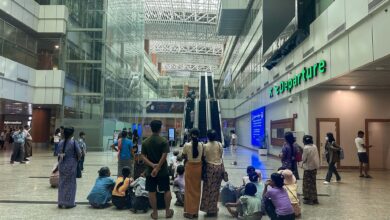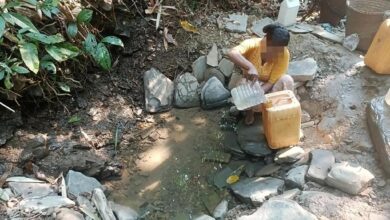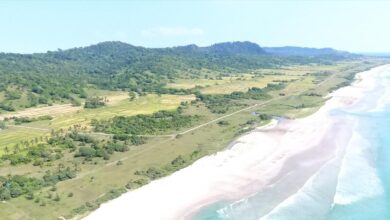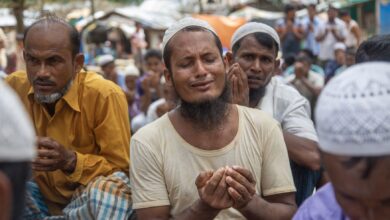
More than five years after the Myanmar army’s genocidal violence that forced some 700,000 Rohingya Muslims to flee to Bangladesh, Myanmar Now continues to unveil new details about the horrors inflicted at that time, and how the current regime has continued a campaign to erase the minority’s claims to their homeland.
Much of what is known about the 2017 attacks has come from witness testimony given by Rohingya refugees forced to live in camps outside the country. Yet among the increasing military defections since 2021 coup have been soldiers who participated in the offensive against the Rohingya. In the first article, Myanmar Now spoke to one such officer, whose accounts confirm and provide new support to survivor testimony as international courts continue investigations into past crimes.
The current junta’s forces now occupy much of the land razed and seized by the military in 2017. In the second article, Myanmar Now exposes how hundreds of acres in two townships are set to be handed over to a regime border guard police division, illustrating how Myanmar’s coup has facilitated the continued disenfranchisement of one of the region’s most persecuted communities.
‘Trail of bodies’: defector says military’s top judge came to Rakhine to destroy evidence of Rohingya atrocities
Aung Lin Dwe, who at the time was Judge Advocate General, fabricated cover stories and ordered soldiers to delete files from their phones, according to a defector
By Zaw Ye Thwe

The Myanmar military’s top judge travelled to northern Rakhine State in 2017 to assist with the destruction of evidence of atrocities against the Rohingya, a defector who says he took part in the offensive has told Myanmar Now.
Aung Lin Dwe, who at the time was the Tatmadaw’s Judge Advocate General, arrived in the village of Mawrawaddy near Maungdaw after the attacks against the minority group began in August 2017, according to Captain Nay Myo Thet.
“The Judge Advocate General came to the No. 4 Border Guard Force office in Mawrawaddy, fabricated incidents as the military wanted… and got rid of the evidence of the acts of terrorism the military committed,” he said. “He also altered the weapons and ammunition inventory records.”
Aung Lin Dwe, who now serves as Secretary of the military’s so-called State Administration Council, issued an order in 2017 for soldiers to delete any record of the attacks they had taken on their phones, Nay Myo Thet said, adding that he himself passed this order down to his own subordinates.
“We were told to check our mobile phone every few days and delete whatever photos or videos we had there,” he said.

Much of what is known about the 2017 attacks, which both UN investigators and the United States have labelled genocide, comes from witness testimony given by Rohingya survivors who fled to Bangladesh in their hundreds of thousands.
The offensive, which followed a similar but smaller round of violence against the Rohingya in 2016, involved mass killings, the rape of women, men and children, and systematic arson to destroy hundreds of villages.
Journalists, observers and investigators have been denied access to northern Rakhine ever since, except on tightly controlled media tours, and it has not been possible to gather physical evidence from the sites where atrocities were reported.
Nay Myo Thet abandoned his post in Buthidaung Township in January, taking his wife and five-year-old child with him, to join the Civil Disobedience Movement (CDM) against Myanmar’s coup regime.
The captain, who is 32, graduated from the 51st batch of the Defence Services Academy and from 2015 until his defection served as a squadron commander of Infantry Battalion 233 under Western Military Command. His unit was in charge of providing logistical support for troops.
His wife, Mar Mar, who he married in 2016, is a former police officer from Rakhine. The family has fled Rakhine.
During the 2017 attacks, higher ranking soldiers had a sense that they were unlikely to be held accountable for their crimes, but nonetheless did not want to make things easy for international prosecutors by leaving behind evidence, Nay Myo Thet said.
“They used to say: ‘The noose is very far away. Be careful not to put your neck in the noose yourself. Double-check everything. Instruct your underlings to cover their tracks. Get rid of all the evidence’,” he said.
The military’s engineering battalion was brought in to help with this, he added.
“They bulldozed the land to get rid of the evidence,” he said. “By evidence, I mean dead bodies and the remains of burned houses.”
The military built border guard police stations on the bulldozed land, he said.
Soldiers also poured acid onto the bodies of dead Rohingya in order to prevent them being identified, Nay Myo Thet said.
A 2018 investigation by the Associated Press found that acid had been poured over the bodies of Rohingya buried in mass graves in the village of Gu Dar Pyin, in Buthidaung. Nay Myo Thet told Myanmar Now that he arrived in Gu Dar Pyin after the attacks there and saw the aftermath.
Weapons inventories destroyed
Another way the military erased evidence in Rakhine was by destroying inventory records of weapons and ammunition used in the offensive, said Nay Myo Thet.
He served as a logistics officer during the operations and it was his role to procure food supplies, weapons, and aircraft fuel for the soldiers, he said.
“I was aware of our ammunition inventory because I used to be the supply officer,” he said. “So I know how much and what kind of ammunition the soldiers used. It was, however, off the record, so it meant they were given permission to do whatever they wanted.”
Nay Myo Thet’s battalion was deployed to Maungdaw Township as part of a mission named Zwe Marn Hone, which began in 2016 and continued after August 2017 with the purpose of “clearing” a stretch of land along Myanmar’s western border.
“We destroyed a series of Rohingya villages from Kyi Kan Pyin until Baw Tu Lar,” he said, referring to offensives he took part in in both 2016 and 2017. “It ended after we built a community hall in Baw Tu Lar” in 2017, he added.
A top military official named Lieutenant General Aung Kyaw Zaw, who was later sanctioned for his role in the atrocities, built a pagoda in Baw Tu Lar, which sits at one of Myanmar’s most westerly points, “in order to declare the area as Buddha’s land” Nay Myo Thet said.
During the Zwe Marn Hone mission, Nay Myo Thet said soldiers burned down villages and stripped Rohingya women naked for “searches”.
“The military columns would raid and torch villages and the villages would be burnt to ashes. It all happened before my own eyes,” said the captain, who served in the military for 13 years, seven of which he spent in Rakhine State.

Aung Lin Dwe now serves as Secretary of the military’s so-called State Administration Council (nwayoomyanmar.com)
Military authorities gave permission to ground troops to carry out unannounced searches in the villages and to take whatever they liked, the captain said.
“Every time they arrived at a house, they would make the men step outside and the women stand in a line in the house, and then they would strip them naked and ‘search’ them,” he said. “It didn’t matter if the women were old or young. They’d strip all of them naked. Then they would brag about it proudly.”
He added that the soldiers were also allowed to shoot anyone dead if they tried to run during the searches and that no weapons, apart from kitchen knives, were ever found.
“The people did not have any weapons to fight back but the soldiers were justified in killing them even if they found a kitchen knife” he added.
“They would leave a literal trail of dead bodies behind them after they left the villages. The streets would be filled with rotten smells from the bodies. It was very disturbing,” he said.
Rohingya leaders sometimes sought to prevent attacks by bribing army officers at the entrances of their villages with gold, silver, and other valuables, he added: “They would sell the objects given as bribes by the Rohingya people, including motorcycles and cars, among themselves. It was a big market.”
In 2020, military spokesperson Zaw Min Tun told reporters that three soldiers had been punished for “weakness in following the instructions” during the Gu Dar Pyin attacks, but he declined to name the soldiers or give their ranks.
Nay Myo Thet told Myanmar Now that the three soldiers Zaw Min Tun was referring to reported to a tactical officer named Colonel Naing Oo.
In 2019, Nay Myo Thet said, a lieutenant general named Zaw Myo Win was detained at a jail inside the base of Infantry Battalion 233 in Buthidaung for around six months.
His detention was ostensibly a punishment for his role in the Gu Dar Pyin attacks, Nay Myo Thet said, but it “was just an act”.
“I only know about this because I was there when it happened,” he added. “Everyone thought [he] was jailed for real. However, he was allowed to do whatever he wanted while he was detained. He even got to drink alcohol.”
Zaw Myo Win was commander of ground operations under Light Infantry Division 33, which was responsible for a large share of the 2017 atrocities.
It is unclear if Zaw Myo Win was one of the three soldiers that Zaw Min Tun was referring to in 2020.
There is, Nay Myo Thet said, no desire in the military for any genuine accountability for crimes against the Rohingya.
“The military as a whole thinks that the Rohingya are the source of all the problems,” he said. “They just want the Rohingya people gone. That’s all they want.”
Myanmar junta strips Rohingya of ownership of land they were forced to flee in 2017
By officially transferring ownership of razed Rohingya villages to border guard forces, the regime seeks to erase the final traces of their existence
By Tin Htet Paing, Sa Tun Aung

Noor Kamal, 31, was one of more than 700,000 ethnic Rohingya from northern Rakhine State who marked the fifth anniversary of their painful exodus from their homeland this past August. Now living at the Shofiullah Kata refugee camp in Bangladesh, Noor can hardly imagine what his native village of Myin Hlut, in conflict-torn Maungdaw Township, looks like now.
There was once a large market at the centre of this prosperous village of some 20,000 inhabitants that Noor remembers as his favourite place to be when he was growing up. Now a father with a four-year-old son and a two-year-old daughter, his own parents had three acres of land in Myin Hlut that they farmed to provide for their children. When he and his family were forced to flee in 2017, Noor was running a pharmacy in the village.
Since then, the entire village has been razed to the ground—burned and bulldozed by the military forces that emptied it of its Rohingya residents. Most of the land where the village once stood is now occupied by border guard forces under the command of the junta that seized power in February 2021.
Now, five years after taking this land from those who had lived there for generations, the regime is preparing to officially transfer ownership to its current occupiers, according to documents seen by Myanmar Now. A total of more than 700 acres in two townships—Maungdaw and Buthidaung—are about to be handed over to the military-controlled No. 1 Border Guard Police Division Office, the documents show.
Reversing an NLD directive
In September, the regime’s deputy minister of home affairs, Maj-Gen Soe Tint Naing, sent a letter to Zaw Than Thin, the permanent secretary of the Ministry of Union Government Office, requesting permission to repeal a “regional directive” issued by Maungdaw’s General Administration Department (GAD) two years ago restricting the use of lands abandoned by “Bengalis”–the term used by Myanmar authorities to deny the ethnic identity of the Rohingya. He said in the letter that the purpose of the repeal was to “officially register the ownership of those lands under the No.1 Border Guard Police Division Office.”
In response to the request from the Home Affairs Ministry—which manages Myanmar’s border guard forces—Zaw Than Thin ordered the junta’s Rakhine State Administration on October 8 to proceed with the repeal.

Noor Kamal is pictured at his house in Myin Hlut village before the 2017 violence in Maungdaw (Supplied)
Although this move did not come as a surprise, it is significant because it marked the official cancellation of a belated effort by Myanmar’s ousted civilian administration to prevent the illegal occupation of land belonging to Rohingya forced to flee military “clearance operations” in 2017. On February 15, 2020, the Maungdaw Township GAD was instructed by the then National League for Democracy (NLD) government to issue a directive barring “individuals not associated with [the affected land] from living, growing crops, and farming there.” That directive was signed by Zaw Than Thin, who was also permanent secretary of the Ministry of Union Government Office under the NLD.
When he spoke to Myanmar Now by phone in mid-October, Noor was not aware of the junta’s plan. However, he knew that it was unlikely he would ever be allowed to return to his birthplace or reclaim his family’s land under the current regime.
“We have been persecuted and discriminated against like this for a very long time. There is nothing we can do if they decide to confiscate our land,” he said.
While land confiscation by the military has long been a problem faced by ordinary citizens all over the country, the Rohingya have always been especially vulnerable to this practice due to their lack of official recognition by successive military regimes.
In the 1990s, the Rohingya were subjected to ever-worsening persecution by the Maungdaw-based Border Immigration Headquarters—better known by its Burmese acronym, Na Sa Ka—which enforced restrictions that extended from their freedom of movement to their right to marry and have children. Land and other property was also taken from thousands of Rohingya and used to create “model villages” for settlers from central Myanmar or ethnic Rakhine and other predominantly Buddhist minorities.
According to Nay San Lwin, the co-founder of the activist group the Free Rohingya Coalition, the latest move by the regime means that even if Rohingya genocide survivors are ever allowed to return to Myanmar, they will be forced to live in concentration camps, like those created for displaced Rohingya villagers in Sittwe, the state capital.
“All these lands must be returned to their Rohingya owners once a democratic government is back in power,” he told Myanmar Now.

The copy of a document that proves an Inn Din villager’s legal ownership of his land (Supplied)
A vacuum left by violence
Noor and his four sisters grew up in a wooden house in Myin Hlut, which is located about 25km southeast of the town of Maungdaw. He graduated from high school in 2012, but wasn’t able to continue his studies in Sittwe, because of the outbreak of violent clashes that year between the Rohingya and the majority Rakhine people. So he stayed in Myin Hlut, where he worked as a tutor for primary and middle school students while running a pharmacy.
At the time, he hoped that the tensions would soon blow over. However, when a second wave of violence—this time carried out by the military—struck five years later, he and the other residents of Myin Hlut were all completely swept away by it, leaving a vacuum that the military was quick to fill.
According to the documents seen by Myanmar Now, the junta’s No. 9 Border Guard Force currently occupies more than 200 acres of Myin Hlut, including more than 150 designated as restricted land covered by the NLD directive.
“Those were lands owned by us since the time of our ancestors. They built houses and villages, grew crops, and paid taxes,” said a former Myin Hlut village administrator who is now living in the Balukhali refugee camp in Cox’s Bazar, Bangladesh. A fire destroyed much of the camp in March of last year and also left more than a dozen Rohingya refugees dead.
For Mohammed Rezuwan Khan, 25, the confiscation of his family’s land is just the latest of many injustices that Myanmar’s military has committed against the country’s Rohingya community.
“I feel very sad hearing this news. The military confiscating our lands like this is very unfair,” he said from the Kutupalong refugee camp in Cox’s Bazar, where he now lives.
Before fleeing to Bangladesh, Mohammed owned 15 acres of land in Inn Din, a village that made international headlines when a Reuters investigation exposed the military’s murder of 10 locals there in 2017. For their coverage of this notorious incident, two local reporters for the London-based news agency were arrested and sentenced to prison. Among the victims were two young men that Mohammed had taught English to when he still lived there.

Red arrows identify Rashid Ahmed, 18, and Abulu, 17, who were former students of Inn Din villager Mohammed Rezuwan Khan killed in the infamous Inn Din massacre.
Where Inn Din once stood, there are now border guard outposts that occupy more than 180 acres of land, including 129 acres designated as belonging to Rohingya residents.
Getting rid of the evidence
Nay Myo Thet, a 32-year-old army captain who deserted his post in Buthidaung Township earlier this year to join the Civil Disobedience Movement, witnessed first-hand the military’s efforts to erase the Rohingya from northern Rakhine State.
Now living in India with his wife and five-year-old child, he told Myanmar Now in an interview shortly after his defection that an engineering battalion was sent to the area when he was there to remove not only the charred houses that had been torched by soldiers, but also the remains of those who had lived in them.
“They bulldozed the land to get rid of the evidence,” he said. “By evidence, I mean the dead bodies and what was left of the houses that had been burned down.”
Nay Myo Thet said he spent more than half of his 13 years in the military in Rakhine State, where his battalion was deployed to take part in a mission to “clear” a stretch of land along Myanmar’s western border by destroying a string of Rohingya villages in Maungdaw Township.
“The military columns would raid and torch villages and burn them to ashes. It all happened before my own eyes,” he said of the mission, which began in 2016 and continued until August of the following year.
Nay Myo Thet said he also witnessed the aftermath of another notorious incident in the village of Gutarpyin, where an Associated Press investigation uncovered Rohingya bodies buried in mass graves. Some of the bodies had acid poured over them, according to the AP report.
A subsequent court martial held to try those responsible for the massacre was merely a “performance” to hide the military’s crimes, he said.
‘They want the Rohingya gone’
Under the junta’s arrangement, the border guard outposts that the army built at that time will soon take official possession of the Rohingya community’s lands. In addition the land in Myin Hlut, this includes 120.06 acres in Myo Thu Gyi (Yar Zar Bi), 205.21 acres in Aung Sit Pyin, 103.40 acres in Zin Paing Nyar, and 9.98 acres in Ah Lel Chaung.

A map shows the locations of border guard outposts in northern Rakhine State’s Maungdaw and Buthidaung townships (Supplied)
According to Nay Myo Thet, this move effectively settles the matter for the military, which has no interest in accepting responsibility for its treatment of the Rohingya, which it considers entirely justified.
“The military as a whole thinks that the Rohingya are the source of all the problems,” he said. “They just want the Rohingya people gone. That’s all they want.”
The former Myin Hlut village administrator who is now forced to live in theBalukhali refugee camp in Bangladesh agreed that the regime is intent on “erasing” the Rohingya community once and for all.
“By uprooting our lives, they are trying to erase our people, our ownership and our community,” he said.
For Noor, however, his home will always be the village on Myanmar soil where he grew up, even if it has been ploughed into the ground like so many others in northern Rakhine.
“Even if we are living in a Bangladesh refugee camp, our souls are in Myanmar. We are like prisoners here. When can we return to our homes?”



